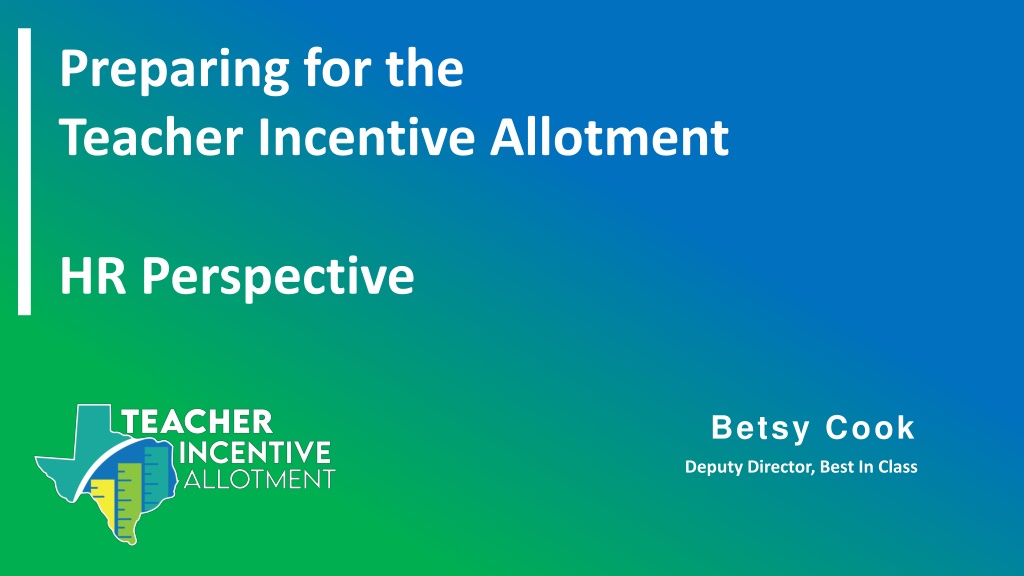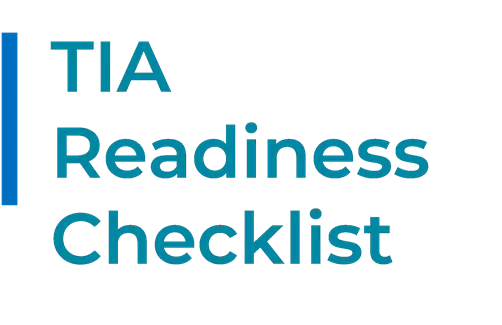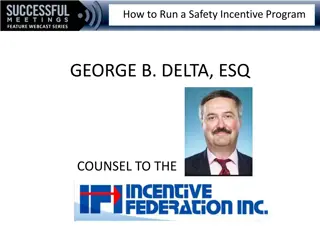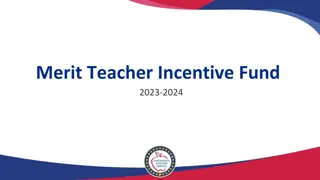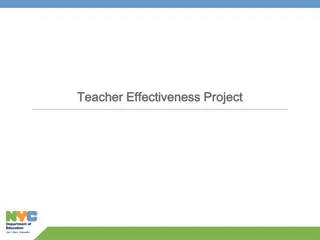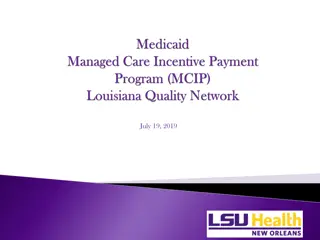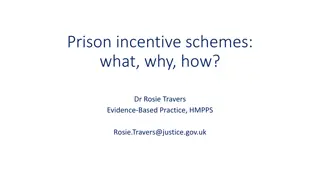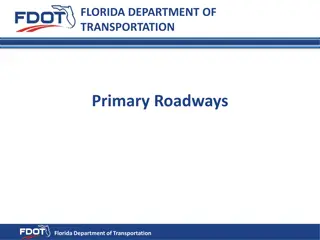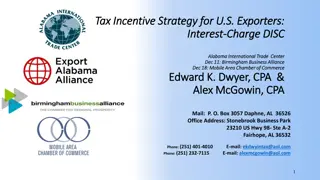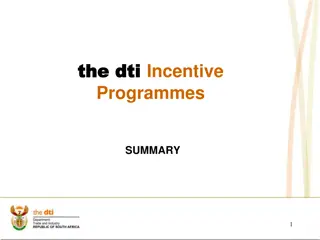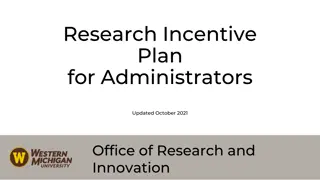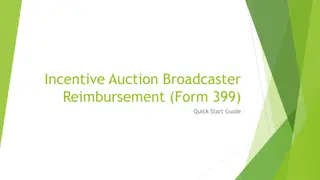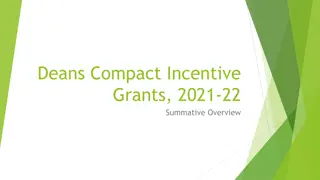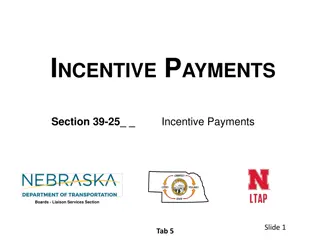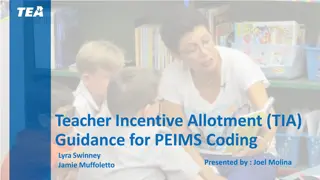Teacher Incentive Allotment HR Perspective Overview
Explore the strategic approach to aligning the Teacher Incentive Allotment (TIA) with current evaluation systems, emphasizing factors like teacher observation, student performance measures, and additional considerations. Delve into the TIA Readiness Checklist for six key success factors and the importance of starting with the reasons for pursuing TIA. Learn how to build upon these reasons to support teacher growth, enhance equity, maintain competitiveness, and effectively communicate and engage stakeholders for successful implementation.
Download Presentation

Please find below an Image/Link to download the presentation.
The content on the website is provided AS IS for your information and personal use only. It may not be sold, licensed, or shared on other websites without obtaining consent from the author. Download presentation by click this link. If you encounter any issues during the download, it is possible that the publisher has removed the file from their server.
E N D
Presentation Transcript
Preparing for the Teacher Incentive Allotment HR Perspective Betsy Cook Deputy Director, Best In Class
Aligning TIA to current evaluation system Observation based on T-TESS or locally-developed rubric District application must show evidence of validity & reliability. Teacher Observation T-TESS Student Performance Student performance measures determined by district District application must show evidence of validity & reliability. Optional: Additional Factors Districts may consider additional factors in making designations (e.g., mentoring other teachers, student surveys, etc.).
TIA Readiness Checklist 6 Success Factors For Consideration 1. Strongly Calibrated Teacher Observation System 2. Accurate & Reliable Measures of a Teacher s Impact on Student Growth 3. Developing a Local Designation System 4. TIA Rollout Communication Plan 5. Plan for Spending Allotment Funds 6. Sustainability of Local Designation System https://tea.texas.gov/sites/default/files/readiness_checklist_cohorts_c-d.pdf
Begin with WHY are you pursuing TIA? Increase Student Achievement Support Teacher Growth Increase retention of the most effective teachers Increase equity of access to most effective teachers Opportunity to strengthen current evaluation system Remain competitive in a tight labor market Use State dollars to increase teacher salaries
Build with your WHY in mind Consider using the TIA Additional Factor Component, create a Professional Development measure or micro-credentials or a leadership measure Support Teacher Growth Consider TIA Spending plan structure, increase % of TIA designation dollars to teachers who serve a priority list of campuses Increase equity of access to most effective teachers Consider TIA Spending plan structure, maximizing % paid to the teacher holding TIA designations Remain competitive in a tight labor market
Communication is not enough you must engage people to build commitment Communication Engagement Simple, continuous messaging, discussions, and participation Networked and two-way, with active listening & acknowledgement (e.g., focus groups or change program hotline) Uses influence as much as hierarchy Addresses people in big groups (e.g., website announcement or mass email) Largely outbound information dissemination Necessary but not sufficient in times of major change Drives awareness and curiosity for engagement, but only the beginnings of understanding Drives understanding and acceptance by giving individuals a voice (indirect control)
Bring everyone into the process, early and often Communications School Leadership Campus Leadership & Teachers Human Capital Management Employee Organizations Evaluation & Assessment Teaching and Learning Budget/Finance
TIA Policy Impacts & Considerations Transfer Policy Will movement outside of the transfer window be allowed? Does a higher TIA payout equal a promotion? Do you need guidelines for competition/recruitment within district for TIA designated teachers? Compensation Policy What will payout schedule be for a TIA designated teacher new to your district? What will be the impact to the teacher s TIA payout when a change in assignment required by the district and/or campus? DK Is there alignment of DK, Assignment & Schedules Policy with your local evaluation system? TIA Submission Will you require the teacher to still be employed with your district to be submitted for TIA? Will you require that they still be in a teaching role? Will you have an appeal process? Or use existing Grievance policy?
Gotcha Evaluations, with intent to fire or punish teachers Status-Quo, all teachers receive gold stars Compliance Exercise What we are NOT talking about . Creating a Culture of Feedback So what exactly is DIFFERENT in this approach? Using data in traditional Human Resources decisions
RETHINK approach to Human Capital Decisions With a clear information, a district can strengthen strategies on a number of topics: Equity of Access to Strong Teachers and School Leaders Differentiated Professional Development Identification of future school leaders Pairing new/student teachers with high performing mentors Strategic staffing of high-need schools Recruitment based on pipeline analysis Surface opportunities and risks to equity Retention Strategies Career Pathways
With a clear information, a district can strengthen strategies on a number of topics: Equity of Access to Strong Teachers and School Leaders Differentiated Professional Development Identification of future school leaders Pairing new/student teachers with high performing mentors Strategic staffing of high-need schools Recruitment based on pipeline analysis Surface opportunities and risks to equity Retention Strategies Career Pathways
In Texas, As District Poverty Levels Increase, Staffs Reflect More Teachers Who are New to Profession And Higher Teacher Turnover, Resulting in Reduced Achievement For Low Income Students Eco-Dis Student Achievement vs. Teacher Characteristics, by District Eco-Dis Rate (200 Largest ISDs) 50% 42% 40% 38% % of Eco-Dis Students Meeting STAAR Standard (All Grades/All Subjects), 2017 34% TX avg.: 33% 33% 32% 30% 20% % of Teacher Turnover, 2017 16% TX avg.: 16% 16% 15% 13% 13% 10% 10% % of Teachers Who are Beginning, 2017 8% TX avg.: 8% 7% 5% 4% 0% 20-40% 40-60% 60-80% 80-100% 0-20% Districts bucketed by % of students economically-disadvantaged Teachers: Avg. Yrs. Exp. 11.2 11.4 10.8 10.6 10.2 # Districts 15 30 51 67 36 223,117 # Students 727,916 1,081,443 1,463,410 787,427 # Teachers 14,627 47,393 69,988 92,391 50,736 12 Source: TEA TAPR and STAAR, 2017
With a clear information, a district can strengthen strategies on a number of topics: Equity of Access to Strong Teachers and School Leaders Differentiated Professional Development Identification of future school leaders Pairing new/student teachers with high performing mentors Strategic staffing of high-need schools Recruitment based on pipeline analysis Surface opportunities and risks to equity Retention Strategies Career Pathways
Teacher satisfaction with their school increases 60% if they are provided differentiated and effective professional development
Professional Development Planning is guided by: Top performing teachers are often asked to lead PD 1/3 hours: Prescribed 2/3 hours: Choice 2/3 hours: Prescribed 1/3 hours: Choice Teacher Observation Score Determines Path
With a clear information, a district can strengthen strategies on a number of topics: Equity of Access to Strong Teachers and School Leaders Differentiated Professional Development Identification of future school leaders Pairing new/student teachers with high performing mentors Strategic staffing of high-need schools Recruitment based on pipeline analysis Surface opportunities and risks to equity Retention Strategies Career Pathways
Paying Teachers More, With a Focus On Equity More Poverty Poverty Tiers HB 3 establishes an optional Teacher Incentive Allotmentwith a stated goal of a six figure salary for teachers who prioritize teaching in high needs areas and rural district campuses 0 0.5 Tier 5 1 2 3 4 Non Eco-Dis Tier 4 Tier 3 Tier 2 Tier 1 Recognized Non-rural $ 3,000 $ 3,750 $ 4,500 $ 6,000 $ 7,500 $ 9,000 Rural $ 6,000 $ 6,750 $ 7,500 $ 9,000 $ 9,000 $ 9,000 Exemplary Non-rural $ 6,000 $ 7,500 $ 9,000 12,000 $ 15,000 $ 18,000 $ Funding ranges from $3,000 - $32,000 per teacher per year, using new Compensatory Education spectrum system Rural 12,000 $ 13,500 $ 15,000 $ 18,000 $ 18,000 $ 18,000 $ Non-rural 12,000 $ 14,500 $ 17,000 $ 22,000 $ 27,500 $ 32,000 $ Master At least 90% of these funds must be spent on compensation of teachers at these campuses Rural 22,000 $ 24,500 $ 27,000 $ 32,000 $ 32,000 $ 32,000 $ More Funding
With a clear information, a district can strengthen strategies on a number of topics: Equity of Access to Strong Teachers and School Leaders Differentiated Professional Development Identification of future school leaders Pairing new/student teachers with high performing mentors Strategic staffing of high-need schools Recruitment based on pipeline analysis Surface opportunities and risks to equity Retention Strategies Career Pathways
Strong leadership in schools is essential, but many of the most talented people aren t becoming principals NATIONAL DATA But, only ~15% of educators and support leaders believe the MOST TALENTED PEOPLE BECOME PRINCIPALS 97% of respondents believe effective principals are CRITICAL TO SCHOOL SUCCESS 1 1) Excludes CMOs Source: Bain School Leadership Study 2013, based on survey of 7 urban districts and CMOs, n=4200
Re-thinking Mentors HB 3 establishes a Teacher Mentor Program Allotment to fund stipends for mentors and other costs associated with mentoring teachers in their first two years Website: Tea.Texas.gov/mpa Email: MPA@tea.texas.gov Best Practices: Include application process for Mentors Set a minimum number of years of service Set performance standards: Strong performance of teacher on T-Tess, demonstrated student growth Provide framework for mentor/mentee working relationship Training, Frequency of meetings, clear objectives/topics for meetings
Contact Info Betsy Cook Deputy Director, Best in Class Communities Foundation of Texas bcook@cftexas.org
